Render
| Toolbar | Menu |
|---|---|
|
|
Render Render |
The Render command renders the model using the current renderer producing a color image in a separate display window.
To set the current renderer
- On the Render menu, click Current Renderer.
- Choose the renderer from the list.
Note
- The materials assigned from the Materials panel to either with the Properties command or the Layers determine the colors of the rendered objects.
- If the objects you are rendering are very complex, Rhino may be slow to shade or render them the first time. It is during that time that Rhino calculates from the smooth geometry a hidden mesh that is used for the rendering. The next time you render the same model, the performance will have improved.
Rendering basics
In addition to shaded previews, Rhino provides full-color rendering with lights, transparency, shadows, textures, and bump mapping.
Objects will render white until you add render color, highlight, texture, transparency, and bumps. These attributes are controlled through the Properties panel, Material page.
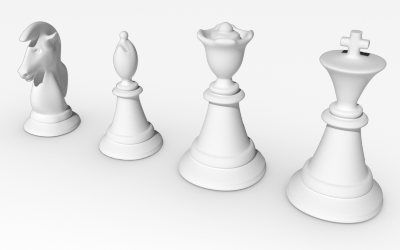
The process needed to render scenes consists of four basic steps:
-
Set up the environment and ground plane
-
Add lighting
-
Assign materials
-
Render
Although the steps do not have to be done in this order, using this method seems to make setting up a scene more efficient. To improve quality, repeat these steps until the image looks right to you.
Lights
In every Rhino rendering there are light sources that Rhino uses to calculate how the objects are to be illuminated. If you do not add any light sources to your scene, the default light is used. The default light is a directional light with parallel rays that acts as though you have a lamp shining over your left shoulder.
 Add indoor lights or
Add indoor lights or  sun
sun
- Insert Spotlights, Directional Lights, Linear Lights, Point Lights, or Rectangular Lights.
Or turn on the Sun.
Materials
Materials specify the color, finish, transparency, texture, and bump for use by the renderer.
 Assign materials to layers
Assign materials to layers
In the Materials panel
Assign to Layers...
- Right-click on a material and select Assign to Layers...
- In the Choose Layer dialog, select layers.
Assign to Layers of Objects
- Right-click on a material and select Assign to Layers of Objects
- Select an object in the viewports to assign the material to the object's layer.
In the Layers panel
- Select one or more layers by clicking their names.
- Click in the Material column of a selected layer.
-
In the Layer Material dialog, select or create a material.
Type a letter to navigate to the first material in the list with a name starting with the letter.
By selecting objects
- Select one or more objects.
- In the Materials panel, right-click on a material and select Assign to layers of Objects.
By drag and drop
- Drag a material from the Materials panel and drop it onto a layer in the Layer panel.
 Assign materials to objects
Assign materials to objects
In the Materials panel
- Select one or more objects.
- In the Materials panel, right-click on a material and select Assign to Objects.
In the Properties panel
- Select one or more objects.
- In the Properties panel, click the Material button.
- Select or create a material from the drop-down list.
By drag and drop
- Drag a material from the Materials panel and drop it onto an object.
The object highlights when the cursor is over it.
Ground Plane
The ground plane provides an infinite horizontal platform for the image that stretches to the horizon in all directions positioned at a defined elevation. A ground plane renders much faster than using a surface as a background. Any material can be assigned to the ground plane.
 Set up a ground plane
Set up a ground plane
- Open the Ground Plane panel.
- Set up ground plane properties.
Environment
Environments describe the space around the model. This space is reflected in objects and can provide overall lighting.
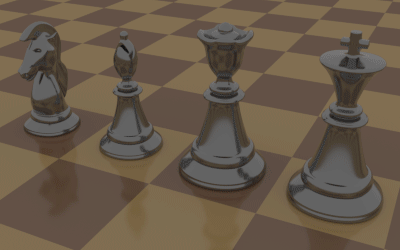
 Set up an environment
Set up an environment
The rendering properties include environment settings like background color and image.
- Open the Environment Editor panel.
- Set up environment properties.
Render
Render and save an image.
 Render and save the image
Render and save the image
- On the Render menu, click Render.
-
In the Render Window, on the File menu, click Save As.
Rhino Image File Format (.rimage)
Rhino Render can save .rimage files. This is a proprietary file format that stores all of the information rendered by the rendering engine, including color, alpha, depth, normal channels, all with 32-bit per-channel resolution.
This information is used by the render window to execute the post-effects and exposure operators, and can also be used by custom controls implemented by a third-party renderer to achieve other effects.
Immediately after render time, the .rimage format can be used to store the data so that post-processing and exposure adjustments or format changes (saving in a different format without loss of information) can be done later.
The .rimage format is only supported by the Rhino render window. It cannot be loaded into any other software. It is a high-dynamic range format that supports lossless information transfer to .HDR and .EXR formats. It is uncompressed and the files can be huge.
To open an .rimage file
- In the Rhino render window, on the File menu, click Open.
Or - Use the RenderOpenRenderImage command to open an .rimage file without having a render window open.
Completed renderings are saved in the .rimage format to a temporary location on your hard disk. Once one of the renderings is re-opened, all post effects and exposure settings are available as if the rendering were just completed.
To open the most recent .rimage file
- In the Rhino render window, on the File menu, click Recent, and then choose a file.
The files are named the by date and time of the rendering.
For more information about post processing the rendered image, see: Post-processing rendered images.
Render command-line/scripting commands
|
Toolbar |
Menu |
|---|---|
|
|
Render Batch Render Named Views |
The BatchRenderNamedViews command renders all the named views in the model and saves the renderings as image files to a folder.
Steps
-
Save the views to render as named views.
-
Set the rendering settings.
-
Start the BatchRenderNamedViews command.
-
Select a folder.
The named views are rendered in the list order and saved with their names.
See Also
NamedView
Manage the named views.
| Toolbar | Menu |
|---|---|
|
|
|
The RenderArctic command sets everything to white - materials, skylighting, ground plane and renders the current viewport.
| Command-line options | |
|---|---|
| AffectMaterials | Turn off to exclude materials from the settings. |
| AffectLights | Turn off to exclude lights from the settings. |
| AffectGroundPlane | Turn off to exclude groundplane from the settings. |
| AffectBackground | Turn off to exclude background from the settings. |
See: Wikipedia: Ambient occlusion.
| Toolbar | Menu |
|---|---|
|
|
|
The CloseRenderWindow command closes the render display window.
This is useful for doing multiple renderings. When combined with the SaveRenderWindowAs command, you can create multiple renderings and save them to different files from your script.
| Toolbar | Menu |
|---|---|
|
|
|
The CopyRenderWindowToClipboard command copies the image in the render window to the Clipboard.
| Toolbar | Menu |
|---|---|
|
|
|
The RenderBlowup command renders a selected area of the current viewport in the render window at the resolution specified in the Rendering panel.
| Toolbar | Menu |
|---|---|
|
|
|
The RenderInWindow command renders a selected area of the current viewport in the render window at viewport resolution.
| Toolbar | Menu | Panel Gear Menu |
|---|---|---|
|
|
Panels Rendering |
Rendering |
The Rendering command opens the Rendering panel that provides quick access to the Render Document Properties.
Current Renderer
Sets the current renderer. This can be the built-in Rhino Render or a plug-in.
View
Specify a source for the view.
Current Viewport
Renders the current viewport.
Specific Viewport
Select a viewport to render from the list.
Named View
Select a named view to render from the list.
Snapshot
Select a snapshot to render from the list.
Resolution and Quality
Dimensions
The aspect ratio displays to the right of the menu.
Viewport (<size>)
Renders the active viewport the active viewport using the pixel size of the viewport.
Custom (<size>)
Renders the active viewport using the custom resolution. Type the custom width and height resolution in pixels.
Preset sizes
Renders the active viewport the selected pixel resolution.
If you add a text file named render_sizes.txt to the folder where the Rhino executable (.exe) resides, Rhino Render and some other renderers will read this text file for custom render sizes.
Example:
// My custom render sizes
500,500
600,600
700,700
800,800
900,900
Lock to viewport aspect ratio
Maintains the aspect ratio of the viewport. When the height or width is changed, the other dimension changes in relation.
Size
Calculates the size of the image in the selected unit system based on the Resolution and DPI ("dots" per inch) settings. This is useful for determining the size of the image for printing.
Units
Sets the image size in pixels, inches, millimeters, or centimeters.
DPI
Image pixels ("dots") per inch.
Quality
Low quality
Render 15 samples.
Draft quality
Render 50 samples.
Good quality
Render 500 samples.
Final quality
Render 1500 samples.
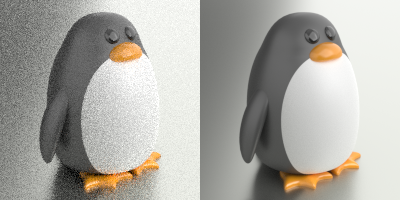
Backdrop
The backdrop is what you see directly in front of the camera if there are no objects in the way. The background is not 3‑D — it exists only on the screen.
Solid color
Displays a solid color.
To select the color for the background
- Click the color swatch.
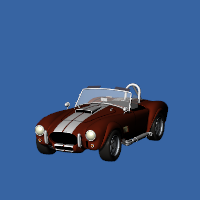
Gradient
Displays a two-color gradient. The color for the top of the image background is the Solid color set above.
To select the color for the bottom of the background
- Click the color swatch.
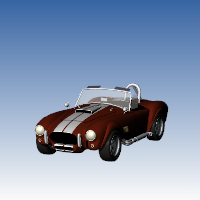
360° Environment
Displays the portion of the current environment that the camera sees in the viewport.
 New
New
Creates a new environment using a template from the library.
 Edit
Edit
Edits the selected environment.
See: Environment Editor.
 Duplicate
Duplicate
Copies the selected environment to a new environment with the same settings.
Wallpaper
Displays the current viewport wallpaper.
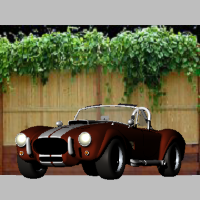
Wallpaper in perspective viewport.
Stretch to fit
Fits the wallpaper to the rendered view.
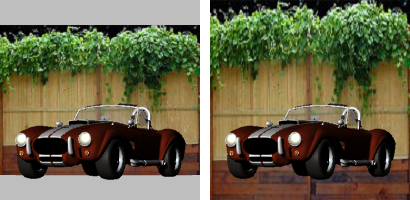
Wallpaper at normal aspect ratio (left) and stretched to fit (right).
Transparent background
The background is rendered with an alpha channel for transparency. The image must be saved to a file format that supports alpha channel transparency (.png, .tga, .tif).
Ground plane
Turns on the ground plane.
Ground Plane Settings
Opens the Ground Plane panel.
Use custom environment for reflections
Assigns a custom environment that will be reflected by objects in the scene.
 New
New
Creates a new environment using a template from the library.
 Edit
Edit
Edits the selected environment.
See: Environment Editor.
 Duplicate
Duplicate
Copies the selected environment to a new environment with the same settings.
Default environments
No environment
The No environment setting applies a plain gray background.
Studio
The Studio environment offers soft lighting provided by a high-dynamic range image.
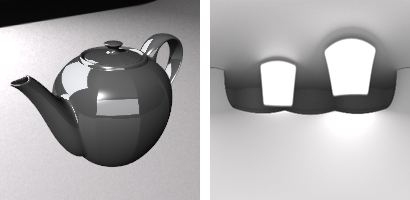
Studio lighting example (left) and hdr background (right).
Lighting
Sun
Turns on the sun.
Sun Settings
Opens the Sun panel.
Skylight
Turns on skylight.

Skylight off (left) and Skylight on (right).
Intensity
Adjusts the skylight intensity.
Use custom environment for skylighting
Sets an environment that is used as sky light.
 New
New
Creates a new environment using a template from the library.
 Edit
Edit
Edits the selected environment.
See: Environment Editor.
 Duplicate
Duplicate
Copies the selected environment to a new environment with the same settings.
Lights
Opens the Lights panel.
Use lights on layers that are off
Controls whether or not spotlights that are on hidden layers or that are hidden with the Hide command are rendered.

Snapshots
The Snapshots command saves and restores Named Views, Named Positions, Layer States, as well as rendering settings, object settings including locked/hidden state, display mode, material, position, light settings, curve piping, displacement, edge softening, shutlining, and thickness.
Wireframe
Render curves
Curve objects are rendered with the surfaces.
Render surface edges and isocurves
Surface isoparametric curves and edges are rendered with the surfaces. Edge thickness set in the Rendered viewport apply.
Render dimensions and text
Dimensions and texts are rendered with the surfaces.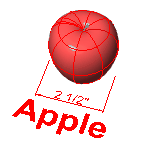

Snapshots
The Snapshots command saves and restores Named Views, Named Positions, Layer States, as well as rendering settings, object settings including locked/hidden state, display mode, material, position, light settings, curve piping, displacement, edge softening, shutlining, and thickness.
Dithering and Color Adjustment
Dithering
The rendered image is usually produced at a higher color depth than monitors and low-dynamic-range file types like bitmaps like JPEG, PNG, BMP can reproduce. The most important effect this causes is banding, which is a quantization error. Dithering reduces quantization errors and so gets rid of banding.
Both dithering methods, generally do the same thing. Sometimes, one might be better than the other, but in general, Simple Noise is the best.
See: Wikipedia: Dither.
None
No dithering.
Floyd-Steinberg
The algorithm achieves dithering by diffusing the quantization error of a pixel to its neighboring pixels.
See: Wikipedia: Floyd-Steinberg dithering.
Simple noise
A random variation of brightness or color information in images.
See: Wikipedia: Image noise.
Gamma
Image files are color corrected so that they can be loaded byte-by-byte into the RGB pixels of a computer screen and look right on a monitor. This means that the color response of a standard image is non-linear, that is, it is gamma corrected. Gamma refers to the power function that is used to correct the image.
The Gamma value changes, and therefore corrects the output of the image.
See: Wikipedia: Gamma correction.
Use linear workflow
The Rendered display mode supports a linear workflow for accurate color, gamma and lighting computation.
Gamma correction for bitmap images that are loaded from disk is removed (by the inverse of the amount in the Gamma edit box) so that they have a linear response before they are passed to the renderer. The renderer renders them in this uncorrected state. The gamma correction is applied to the entire finished image. This can do a better job of processing the color in rendered images.

Snapshots
The Snapshots command saves and restores Named Views, Named Positions, Layer States, as well as rendering settings, object settings including locked/hidden state, display mode, material, position, light settings, curve piping, displacement, edge softening, shutlining, and thickness.
Render Channels
 Automatic
Automatic
Automatically enables the required render channels.
 Custom
Custom
Manually select the render channels to include in the rendering.
RGBA
Represents Red, Green, Blue, and Alpha transparency. It is mainly used for presentations.
Distance
Uses grayscale colors to represent the distance from the camera. The farthest pixel in the rendering is black. the nearest pixel is white.
Normal
Uses RGB values to represent the XYZ coordinates of normal directions. Red=X, Green=Y, and Blue=Z.
Albedo
The unshaded colors. It is the result of rendering a scene with totally uniform lighting and without shadows.
Advanced Rhino Render Settings
Seed
Change the seed value to vary the noise pattern.
Session
Samples
Amount of samples taken per pixel in the Raytraced viewport. More samples means better convergence, thus better quality.
Override Production Render Quality 

When enabled, the Render command will use the samples above to render the scene. Render quality settings will be ignored.
Ray Bounces
Maximum bounces
Maximum number of light bounces. For best quality, this should be set to a high value. However, in practice, it may be good to set it to lower values for faster rendering. Setting the maximum to 0 bounces results in direct lighting only.
Diffuse
Maximum number of diffuse bounces. The ray is generated by a diffuse reflection or transmission (translucency).
Glossy
Maximum number of glossy bounces. The ray is generated by a glossy specular reflection or transmission.
Transmission
Maximum number of transmission (light that is transmitted throughout a volume) bounces.
Volume
Maximum number of volume scattering bounces.
Transparency
Maximum number of transparency bounces.
Texture Baking
Texture Bake Quality
When decal textures, multi-channel textures, procedural textures, or textures using custom mappings are rendered by Rhino Render or in the Raytraced viewport, these texture types are converted into bitmap textures. Baking qualities control the bitmap texture resolution:
Low: 2048 x 2048 pixels
Standard: 4096 x 4096 pixels
High: 8192 x 8192 pixels
Ultra: 16384 x 16394 pixels
When you zoom in close to an object, the types of textures may look pixelated in the rendering if the baking quality is less than required. Using a higher baking quality will fix the problem, but memory usage of the rendering will increase exponentially.
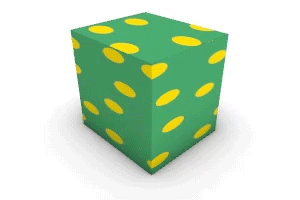
The AdaptiveBakingQuality setting in Advanced settings limits the baking resolution by how big the baked texture pixels appear on the object in the world space. 
- 0 = adaptive baking quality disabled
- 100 = bake to the level of document tolerance
- 200 = bake to the level of 2.00 * document tolerance (default value)
- n = bake to the level of n / 100 * document tolerance
Restores all default rendering settings.
Renders the current model.
| Toolbar | Menu |
|---|---|
|
|
Render Open Last Rendering |
The RenderOpenLastRendering command opens the last rendering image file (.rimage).
| Toolbar | Menu |
|---|---|
|
|
|
The RenderOpenRenderImage command opens a browser window with the recent rendering image files (.rimage).
| Toolbar | Menu |
|---|---|
|
|
Render Render Preview |
The RenderPreview command renders the current viewport in the Render window with a rough quality for a fast preview.
-
10 samples and 2 for all bounce settings are used to render the preview. Rhino Render Advanced Settings are ignored.
| Toolbar | Menu |
|---|---|
|
|
|
The RenderPreviewInWindow command renders a selected area of the current viewport in the Render window with a rough quality for a fast preview.
-
10 samples and 2 for all bounce settings are used to render the preview. Rhino Render Advanced Settings are ignored.
| Toolbar | Menu |
|---|---|
|
|
|
The RenderPreviewWindow command renders a selected area in the viewport with a rough quality for a fast preview.
-
10 samples and 2 for all bounce settings are used to render the preview. Rhino Render Advanced Settings are ignored.
|
Toolbar |
Menu |
|---|---|
|
|
|
The RenderReportImageFiles command opens a dialog box to manage external image files.
This command is an alias of the RenderReportMissingImageFiles command with the Only show missing image files checkbox disabled by default.
| Toolbar | Menu |
|---|---|
|
|
|
The RenderReportMissingImageFiles command opens a dialog box to manage missing external image files.
Options
 Only show missing image files
Only show missing image files
Enable to list only missing images, otherwise to include non-missing images.
Exclude the selected image from the list. It will not be reported as missing again.
Select an image to replace the selected missing image.
Or, double-click a missing image to replace.
Collect the selected images to a new folder. The paths to the images will update.
Find the selected missing images from the online libraries.
Edit the selected render content (material, texture, or environment) that uses the selected missing image.
Or, double-click a render content to edit.
Relocate the folder that includes the missing images.
Copy the file paths of all the missing images to the clipboard.
Save the file paths of all the missing images to a text file.
Close the dialog box.
| Toolbar | Menu |
|---|---|
|
|
|
The RenderWindow command renders a selected area of the current viewport in the viewport at viewport resolution.
| Toolbar | Menu |
|---|---|
|
|
|
The SaveRenderWindowAs command saves the image in the render window to a file.
Steps
- In the Save Bitmap dialog box, choose the name, location, and file type for the bitmap file.
You can save the bitmap in .bmp, .tga, .jpg, .pcx, .png, and .tif formats.
In a script, you can follow the command with the name of the file to save to:
SaveRenderWindowAs "C:/My Images/Rendering Two.bmp".
Save As options
Save alpha channel
Saves an alpha channel if the file type supports transparency.
| Toolbar | Menu |
|---|---|
|
|
Render Current Render |
The SetCurrentRenderPlugIn command specifies the current rendering plug-in application.
You can download plug-ins from www.rhino3d.com/resources.
